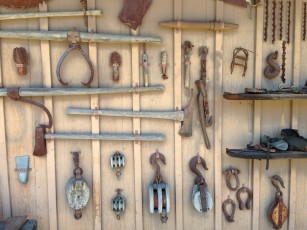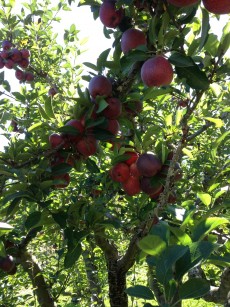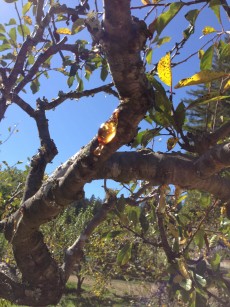
I know where I?m gonna be on Saturday, May11th. St Phillip?s in Scotts Valley s having their 17th annual garden tour and English tea fundraiser for local charities including their own food pantry and community shelter. This year St.Phillip?s has chosen the Teen Kitchen Project as a special recipient for funds. I?ve previously visited two of the gardens on the tour and am looking forward to the others. Here are some highlights of what you can expect on tour day.
The full High Tea Luncheon includes home made scones with jam and cream, a delicious and light soup, sausage rolls and finger sandwiches plus sweet treats such as English toffee and shortbread cookies.
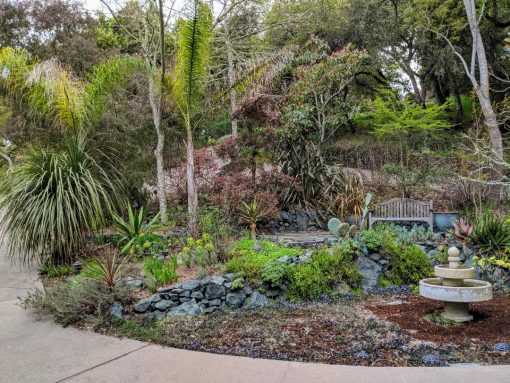
One of the gardens on the tour has been featured several times in my column. Richard Hencke?s garden – I call him Doc – in Scott?s Valley is one not to be missed. From his roots in Oklahoma and Texas he describes himself as the ?Hillbilly Gardener? but with his extensive knowledge of trees, vines and just about anything that grows he is one of the most successful and enthusiastic horticulturists I know. Wear your walking shoes to truly enjoy this garden and the changes he?s made in his landscape over the past few years – before, during and after the drought.
Richard redid his pond a couple years ago. He was tired of fighting the raccoons and algae. Steeper sides will deter the raccoons and deeper water will help to prevent algae growth. He was forced to remove a curly willow that shed leaves into the pond as their natural salicylic acid was poisoning the pond.
Below the patio the golden Mexican marigold and blue Pride of Madeira should be in full bloom along with a gorgeous stand of weeping leptospermum. Among Doc?s passions is creating visual boundaries with flowering vines that grow up into the trees. Richard will be the first to admit that some are growing better than others. Sound familiar in your own garden? Even this expert propagator is sometimes stymied by Mother Nature.
I love to hear Doc Hencke?s stories as he shows me around. Stopping at a China Doll houseplant that has now grown into a tree he tells me he thinks it?s one of the tallest specimens ever. Richard?s new desert garden along the driveway is growing in nicely although he told me that the excessive rains and cold snap this year has caused come havoc. I?m not sure about the yucca he and his brother dug up in Texas that finally bloomed a couple years ago. ?I?ve only waited 52 years for it?, he laughed.
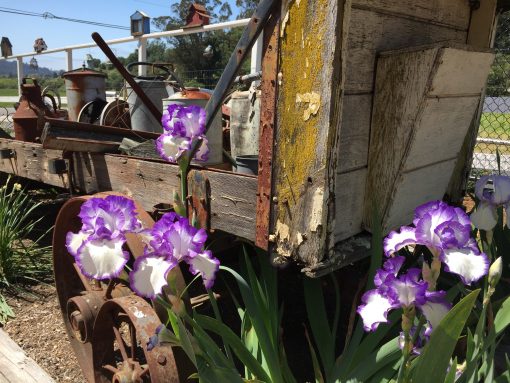
The other garden I?ve had the pleasure to visit is the tall bearded iris farm of Jim and Irene Cummins. Also in Scotts Valley, the iris farm has been so successful that this year when the National Convention is being hosted by Region 14 their garden will be one of the host gardens on the tour.
When I asked Jim for the growing tips last year that make his iris so spectacular he told me he mostly uses lawn trimmings and tree leaves along with the native sand to break the soil down. ?Iris don?t seem to care much as to soil type, they just need good drainage?, he said. He fertilizes with a balanced granular 15-15-15 fertilizer, using only an 1/8 cup or less sprinkled around each clump around Valentines Day and again in August or September. Another tip he told me was to be sure to plant the rhizomes very shallow with only the tops showing and about 12-18 inches apart. They water every 2-3 weeks although he says they can go longer between irrigations.
Among the beds of prized bearded iris there is an impressive antique farming implement collection. This historic property dates back to 1849 when an older house was built as a stagecoach stop. Everywhere you look the Cummins? have created an interesting vignette of plants and artifacts. On the old barn there is an impressive vintage wrench collection as well as dozens of spigot handles. Antique tractor seats, watering cans, washing tubs, rusted bed frames, wagons, old kiddie cars- you name it, Jim and Irene have collected it.
All this and more can be yours when you purchase a ticket for the tour online at http://www.stphilip-sv.net or by calling their office at 831-438-4360.

